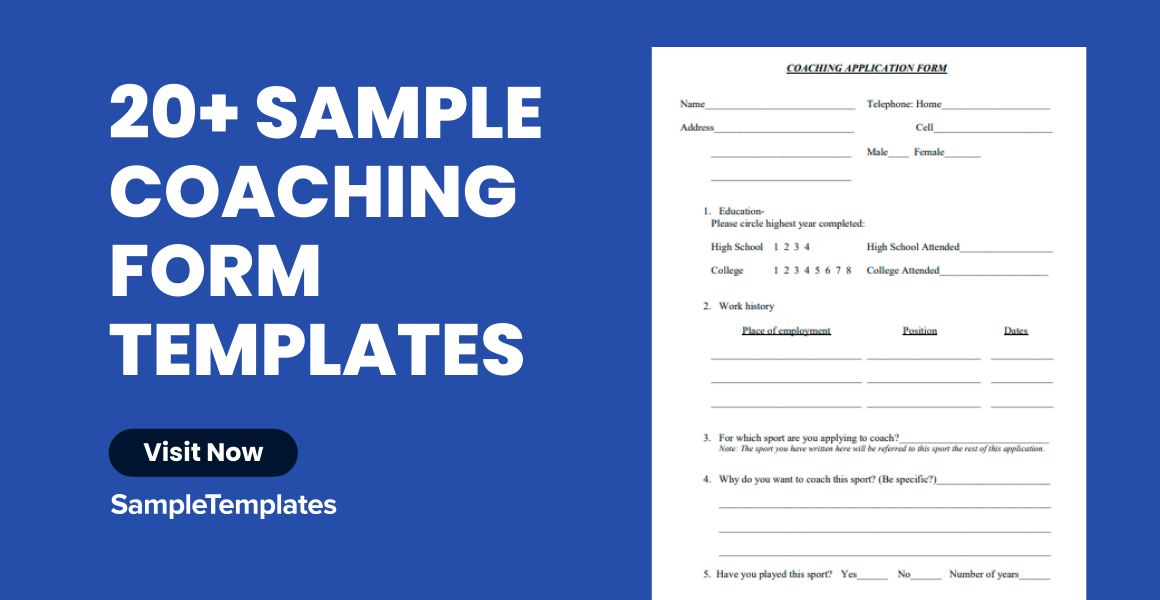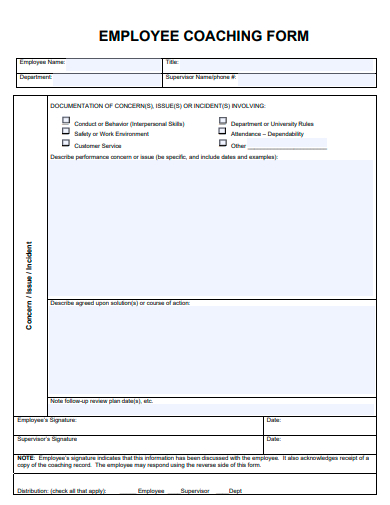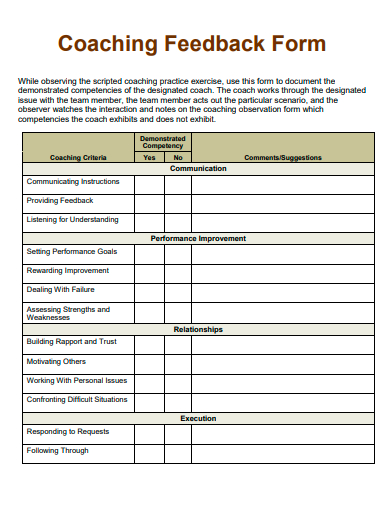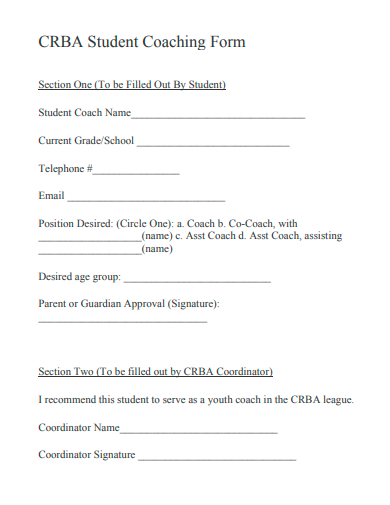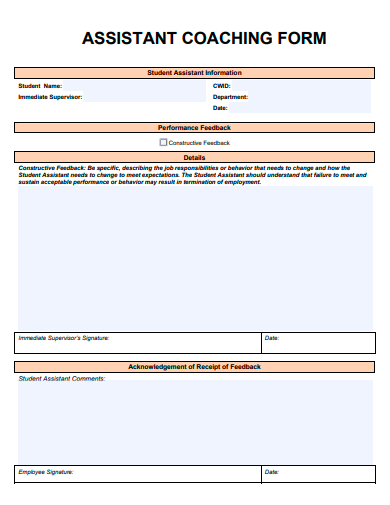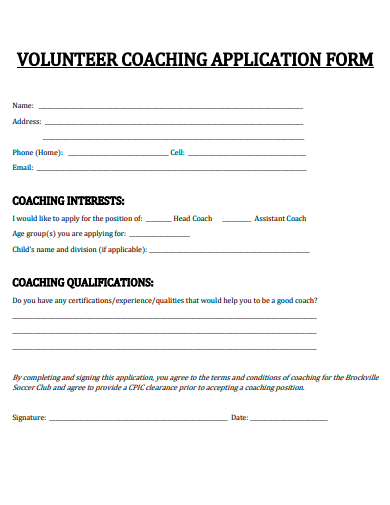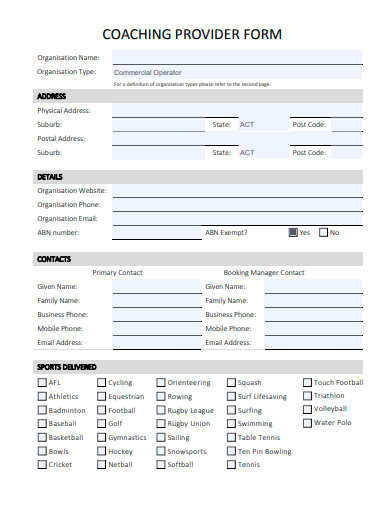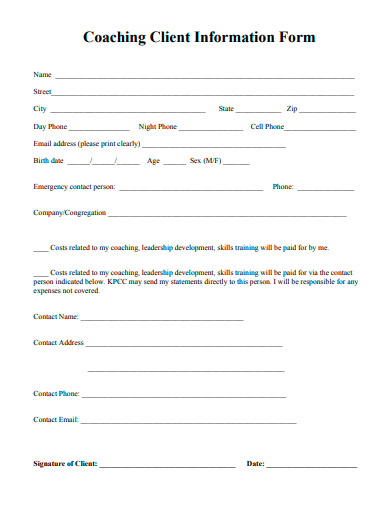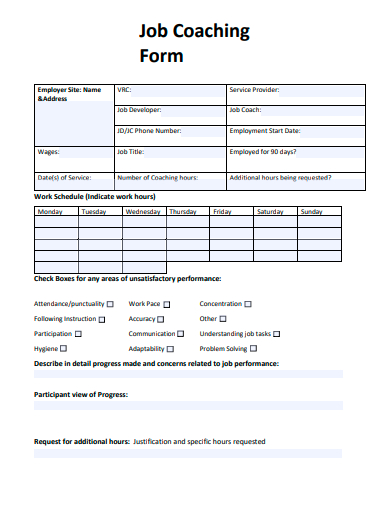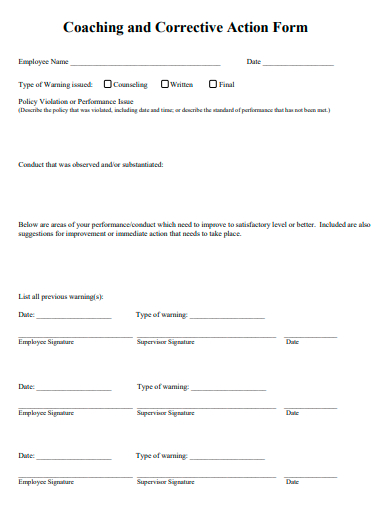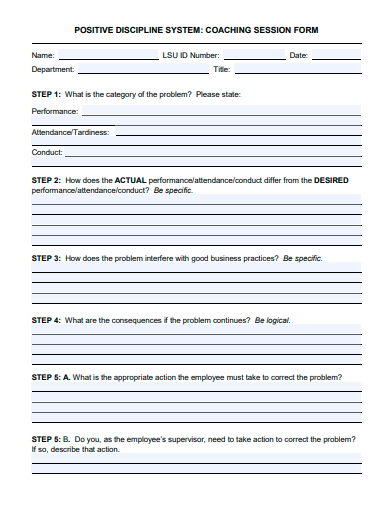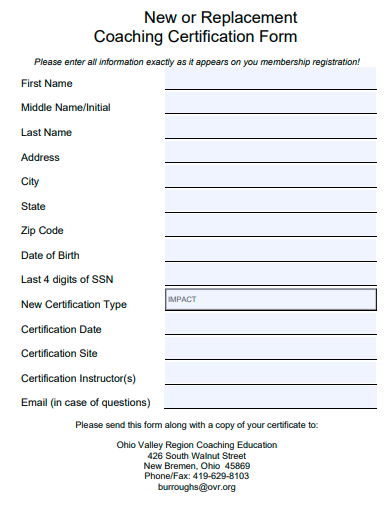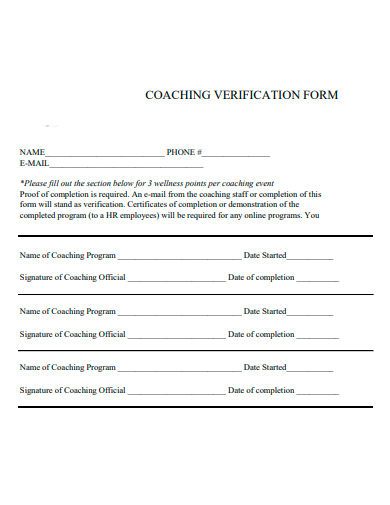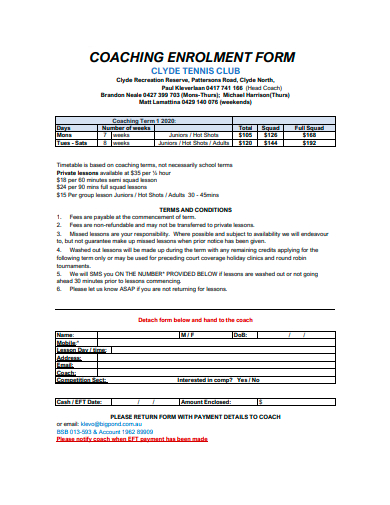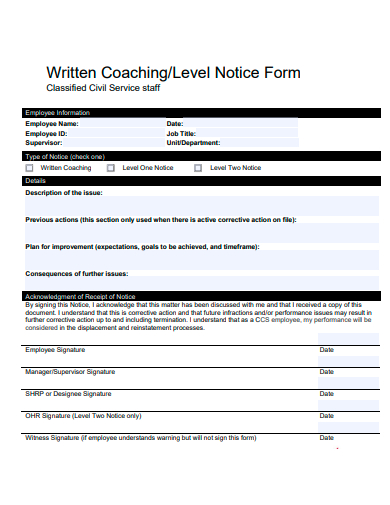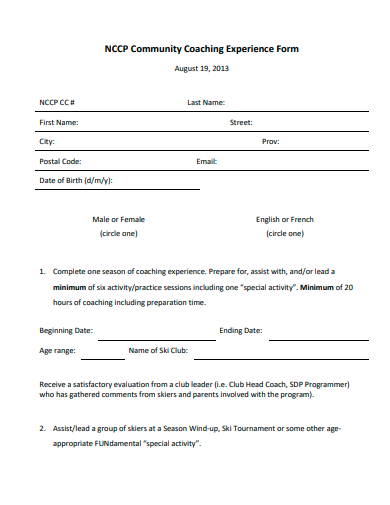Embarking on a coaching journey requires clarity, direction, and the right tools to garner feedback. Our Sample Coaching Form Template, combined with an integrated Feedback Form, is meticulously tailored to ensure structured interactions and valuable insights between coaches and their proteges. This duo not only ensures productive sessions but also captures real-time feedback for continuous improvement. Harness the power of organized coaching and feedback mechanisms, elevate performance metrics, and set the stage for tangible growth. Explore our tools and see how transformative structured feedback can be for your coaching endeavors.
20+ Coaching Form Samples
1. School Coaching Application Form Template
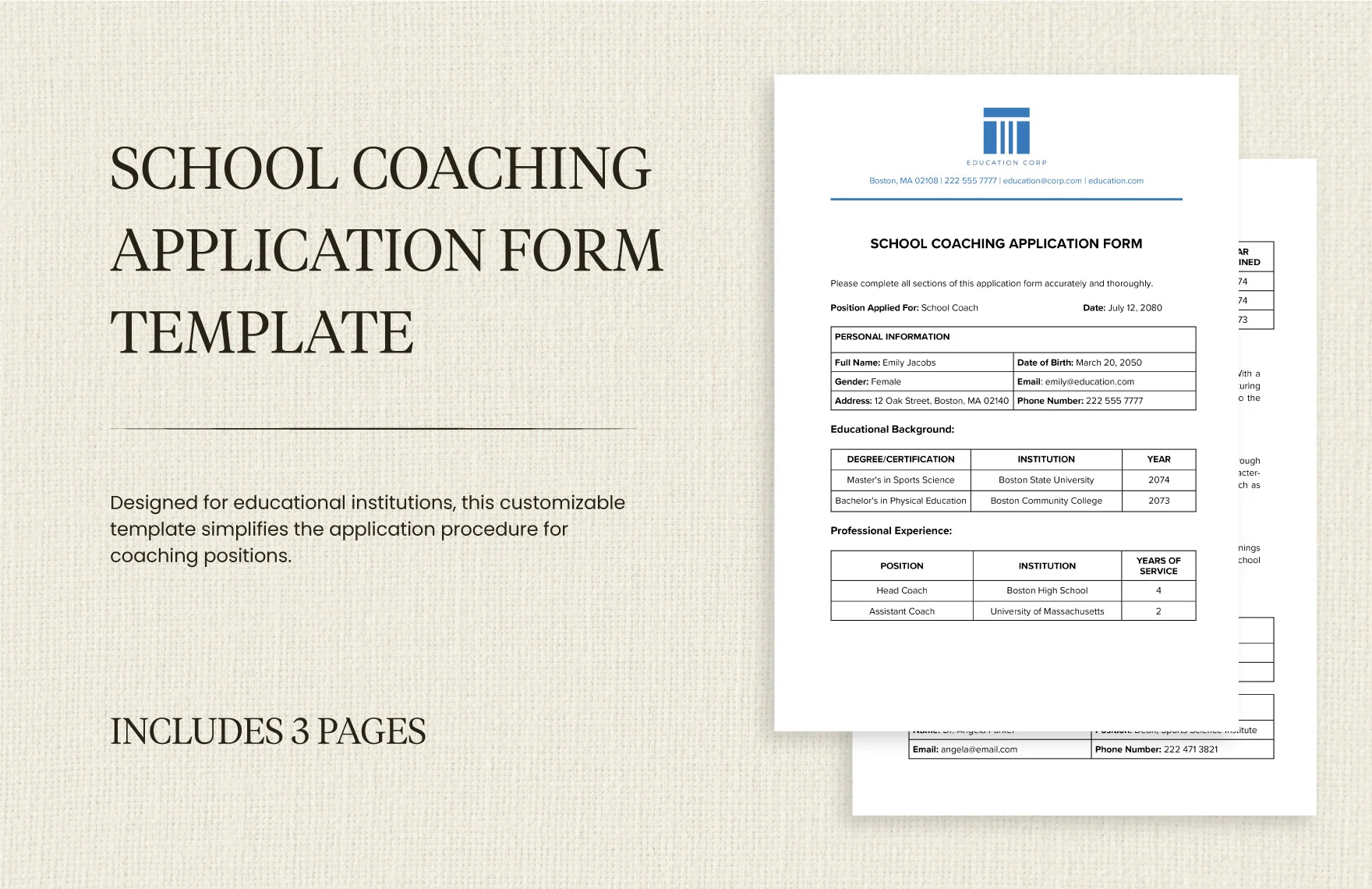
2. School Coaching Performance Evaluation Form Template
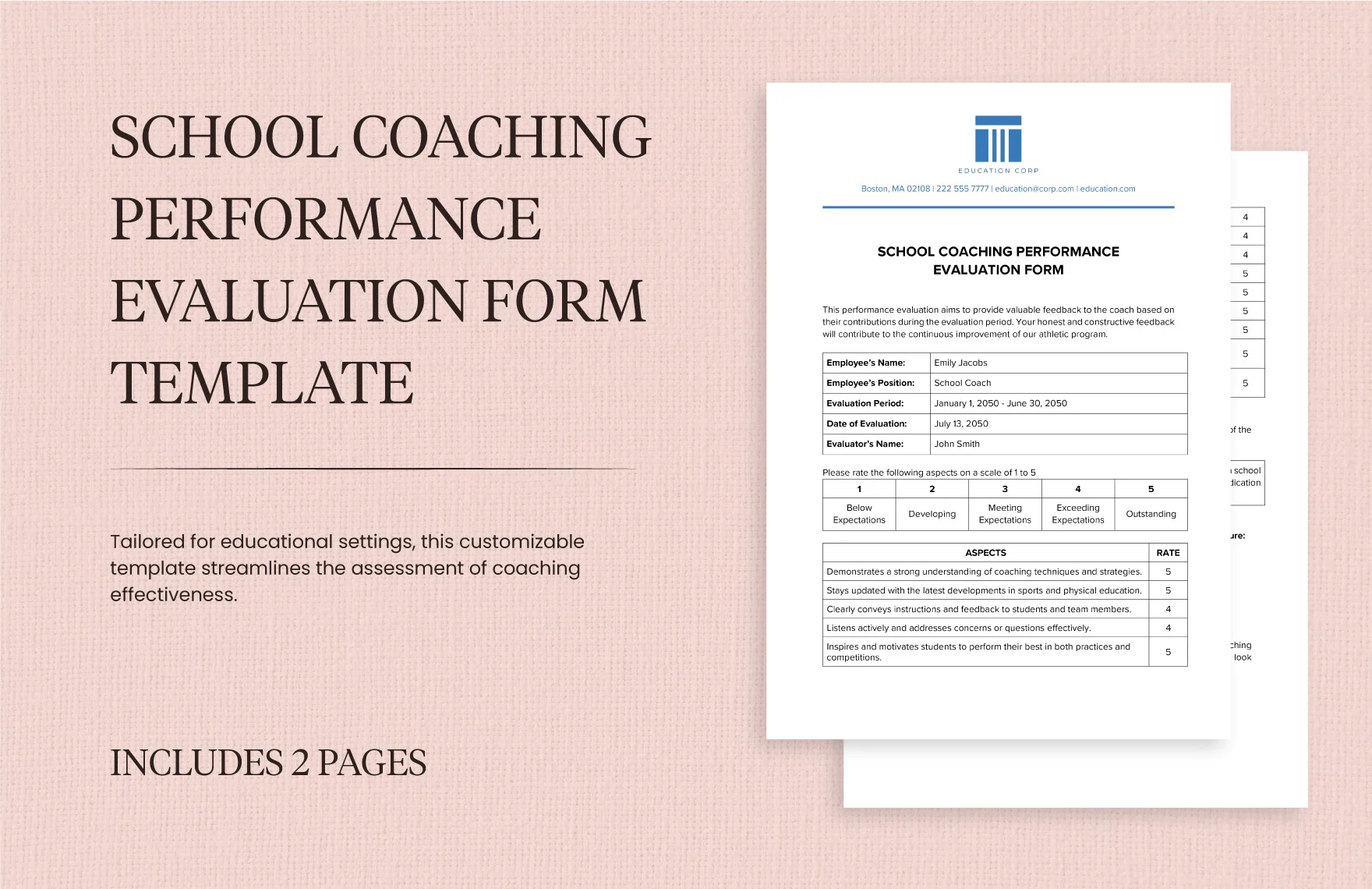
3. Employee Coaching Form Template
4. Sample Coaching Feedback Form Template
5. Student Coaching Form Template
What is a Coaching Form?
Coaching, whether in the realm of personal development, sports, or business, plays an invaluable role in driving growth, fostering skills, and enhancing performance. At the heart of effective coaching lies structured communication and consistent feedback. This is where a Coaching Form comes into play.
Understanding a Coaching Form
A Coaching Form is a structured document or tool used by coaches to guide their sessions with clients or trainees. This form serves multiple purposes:
Setting Clear Objectives: A Coaching Form helps in laying out clear objectives for the coaching session or the overall coaching duration. By setting clear goals, both the coach and the trainee can remain focused on what needs to be achieved.
Tracking Progress: The form often includes sections where past achievements, current benchmarks, and future targets are recorded. This not only provides a roadmap for the trainee but also gives a clear perspective on how they are progressing over time.
Feedback Mechanism: Many Coaching Forms are integrated with Feedback Forms, allowing the trainee or coachee to share their insights, feelings, and thoughts about the session. This two-way communication ensures that the coaching is aligned with the trainee’s needs and aspirations.
Structuring Sessions: Especially in settings where time is limited, having a structured format ensures that each session is maximally productive. The form can guide the flow of the session, from discussing past activities to introducing new concepts or skills.
Documentation and Review: Over time, these forms become a documented history of the trainee’s journey. They can be revisited to analyze patterns, identify strengths and areas of improvement, and adjust strategies accordingly.
Importance of a Coaching Form
In the absence of structured documentation, the effectiveness of coaching can diminish. Here’s why a Coaching Form is pivotal:
Consistency: The form ensures that every session maintains a consistent structure, even if the content or focus varies. This regularity helps in establishing a rhythm in coaching, making it more predictable and efficient for the trainee.
Accountability: Both the coach and the coach have a clear record of what was discussed, planned, and agreed upon. This transparency ensures accountability on both sides.
Reflection: Regularly filling out and reviewing a Coaching Form enables reflection, an essential aspect of learning and growth. It offers an opportunity to celebrate achievements and recalibrate in areas where progress might be lagging.
Professionalism: Using a well-structured form elevates the professionalism of the coaching process. It indicates a level of seriousness and dedication to the craft, enhancing the credibility of the coach.
In the world of coaching, success often hinges on the details. A Coaching Form, while seemingly a simple tool, plays a foundational role in ensuring that coaching sessions are not just meetings, but transformative experiences. By providing structure, fostering communication, and enabling reflection, it acts as a bridge between aspirations and achievements. For anyone in the coaching profession, leveraging such a form is not just recommended; it’s essential.
6. Sample Assistant Coaching Form Template
7. Coaching Application Form Template
8. Volunteer Coaching Application Form Template
9. Coaching Provider Form Template
The Importance of Using Coaching Forms
The journey of coaching, whether in professional, personal, or athletic domains, is an intricate dance of guidance, development, and growth. It’s a process that necessitates organization, clarity, and feedback loops to be truly effective. Central to this structured approach are coaching forms. Their importance extends beyond mere documentation and dives deep into the essence of successful coaching.
1. Streamlined Goal Setting:
At the outset of any coaching endeavor, it’s essential to identify and articulate the goals of the engagement. Coaching forms provide a systematic way to capture these objectives, breaking them down into short-term and long-term targets. This not only gives the coaching relationship direction but also ensures that both coach and coachee are aligned in their expectations and aspirations.
2. Monitoring and Tracking Progress:
One of the most significant benefits of using coaching forms is the ability to track and monitor progress. Over multiple sessions, it’s easy for both parties to lose sight of where they started and how far they’ve come. These sample forms serve as tangible records of achievements, struggles, and milestones, ensuring that progress isn’t just felt, but also documented and celebrated.
3. Ensuring Consistency:
Consistency is key to the success of any coaching relationship. The use of forms ensures that each session follows a structured approach, regardless of the evolving dynamics of the coach-coachee relationship. This structure ensures that key areas of focus are regularly revisited and that the coaching remains aligned with the overarching objectives.
4. Facilitating Feedback:
Many coaching forms incorporate feedback sections, allowing for a two-way exchange of insights and reflections after each session. This process ensures that both parties can voice their observations, concerns, or recommendations, fostering a relationship rooted in open communication.
5. Accountability:
Having documented commitments, sample plans, and feedback ensures that both the coach and coachee remain accountable to the process. It’s a gentle reminder of the responsibilities each party holds, ensuring that tasks aren’t overlooked and that commitments are honored.
6. Professionalism and Credibility:
Using coaching forms underscores the coach’s commitment to professionalism. It sends a clear message to clients that the coach values structure, clarity, and progress in their practice, thereby enhancing their credibility.
7. Reflective Practice:
The act of filling out a coaching form prompts reflection. It encourages the coachee to think about what they’ve learned, how they feel, and where they’d like to head next. Similarly, it offers coaches an opportunity to reflect on their methods, ensuring continuous improvement in their practice.
While coaching is undeniably an art, informed by intuition, experience, and connection, it also requires tools and techniques to optimize its impact. Coaching forms stand out as indispensable tools in this context. They bring structure to the intangible, clarity to the journey, and ensure that the path of coaching is paved with measurable progress, open communication, and mutual respect. For any coach aiming to elevate their practice and deliver transformative results, the use of coaching forms is not just beneficial; it’s imperative.
10. Sample Coaching Client Information Form Template
11. Job Coaching Form Template
12. Summer Coaching Programme Admission Form Template
13. Coaching and Corrective Action Form Template
14. Sample Coaching Session Form Template
Steps in Creating a Coaching Form
Creating a coaching form is an essential step for coaches who want to structure their sessions effectively, track their clients’ progress, and offer a consistent experience. The process of crafting this form requires thoughtful consideration of the coaching process, the goals of the engagement, and the unique needs of each client. Here’s a step-by-step guide to developing a comprehensive coaching form:
1. Define the Purpose:
Before diving into the design and content, it’s crucial to define the primary purpose of the form. Is it for initial assessment, session-by-session tracking, long-term goal setting, or feedback collection? Being clear about its function will guide the subsequent steps.
2. Start with Basic Information:
At the top of the form, include fields for the client’s name, date, contact information, and any other pertinent details. This section ensures that each form is easily identifiable and organized.
3. Outline Session Objectives:
Dedicate a section where the specific objectives for the session can be outlined. This helps in setting the tone and direction for the session, ensuring that both coach and coachee are aligned.
4. Incorporate Goal Setting:
Include a segment dedicated to short-term and long-term goals. This provides clarity about what the client wants to achieve, acting as a roadmap for future sessions.
5. Track Previous Progress:
Add a section where achievements and progress from previous sessions can be noted. This offers a continuous perspective on the client’s journey and celebrates milestones along the way.
6. Feedback Mechanism:
Feedback is a vital component of the coaching process. Incorporate areas where both the coach and client can share their reflections on the session. This might include what went well, areas of struggle, and suggestions for improvement.
7. Action Steps:
End the form with a section dedicated to action steps or homework. This outlines specific tasks or exercises the client should focus on before the next session, providing direction and promoting accountability.
8. Use Open and Closed Questions:
While some parts of the form will have structured, closed-ended questions (like rating scales), also incorporate open-ended questions to capture qualitative insights and feelings from the client.
9. Design for Clarity:
The form should be easy to fill out and read. Use clear headings, bullet points, and distinct sections to ensure the form is user-friendly. Consider digital forms if you want to incorporate dropdown menus, checkboxes, and other interactive elements.
10. Pilot and Refine:
Before finalizing the form, pilot it with a few clients to gather feedback. This will offer insights into any missing elements, unclear questions, or sections that might not be as useful.
11. Keep it Flexible:
Remember, each client is unique. While the form provides a structure, it should also allow for flexibility. Whether it’s adding extra notes or adjusting goals, the form should be adaptable to individual needs.
A well-crafted coaching form is more than just a piece of paper or a digital document; it’s a tool that can significantly enhance the effectiveness of the coaching process. By following these steps, coaches can ensure they have a comprehensive, clear, and effective form that serves both their needs and those of their clients. The goal is to create a seamless blend of structure and adaptability, paving the way for successful coaching engagements.
15. Coaching Report Form Template
16. Coaching Certification Form Template
17. Sample Coaching Verification Form Template
18. Coaching Enrolment Form Template
19. Written Coaching Level Notice Form Template
20. Sample Community Coaching Experience Form Template
21. Coaching Referral Form Template
Elements of an Effective Coaching Form
An impactful coaching journey is a blend of communication, clarity, and actionable insights. Central to orchestrating this harmonious journey is the coaching form, an unsung hero that can profoundly influence the direction and outcomes of the coaching process. Here are some foundational elements that make up a compelling coaching form:
Personalization Fields:
Every individual’s coaching needs are unique. An effective form should allow for a degree of personalization. This could include sections where the coachee can express their learning style, personal challenges, or specific areas they want to delve deeper into.
Visualization Tools:
Graphs, scales, or even color-coded sections can provide a visual representation of progress or areas of concern. These tools can offer both the coach and coachee a snapshot view of the journey, making data more understandable and engaging.
Self-Assessment Segments:
Empowerment is a key ingredient in the coaching mix. Including sections where clients can self-assess their progress or challenges fosters a sense of ownership and can often lead to deeper introspection.
Resource Recommendations:
An effective form might have a dedicated section where coaches can recommend books, articles, videos, or other resources tailored to the client’s current needs, ensuring that learning and growth extend beyond the session.
Commitment Pledges:
Having a section where clients can write down their commitments or pledges for the period until the next session can instill a stronger sense of accountability.
Reflection Corners:
Dedicated spaces for both the coach and coachee to reflect on unexpected insights, moments of clarity, or breakthroughs can capture the essence of a session’s most transformative moments.
Scenario Planning:
A section that allows clients to visualize and plan for potential future scenarios, challenges, or opportunities can be invaluable. It’s a proactive approach, encouraging forward-thinking and preparedness.
Interactive Elements:
In the digital age, where forms might be filled online, including interactive elements like clickable links, video snippets, or even gamified challenges can make the form more engaging and effective.
Holistic Overview:
Beyond professional or specific goals, it’s beneficial to have sections that touch upon the client’s holistic well-being – addressing areas like mental health, work-life balance, and personal passions.
Confidentiality Clause:
Trust is paramount in a coaching relationship. Including a confidentiality clause or section that reaffirms the privacy and security of the client’s shared information can strengthen this trust.
Feedback Loop:
Beyond session-specific feedback, having a recurring segment that seeks feedback on the form itself can be invaluable. It ensures the form evolves, staying relevant and effective.
An effective coaching form is a mirror to the coaching journey, capturing its nuances, challenges, achievements, and aspirations. It’s a dynamic tool, one that should be adaptable and resonant with the ever-evolving nature of personal and professional growth. By incorporating these elements, coaches can ensure they have a holistic, responsive, and impactful tool at their disposal, paving the way for enriched and transformative coaching experiences.
Related Posts
Sample Sworn Affidavit Forms
Vehicle Inspection Forms Samples & Templates
Sample Employee Advance Forms
Sample Child Travel Consent Forms
Sample Testimonial Request Forms
Sample Employee Details Forms
Sample Divorce Forms
Sample Attestation Forms
Employee Performance Appraisal Form Templates
FREE 9+ Sample Presentation Evaluation Forms in MS Word
FREE 10+ School Admission Form Samples & Templates in MS Word | PDF
FREE 30+ Patient Consent Form Samples in PDF | MS Word
FREE 10+ Sample Sign Off Form Templates in PDF | MS Word
FREE 11+ Sample Medical Consultation Forms in PDF | MS Word
FREE 8+ Sample Donation Forms in PDF | MS Word
